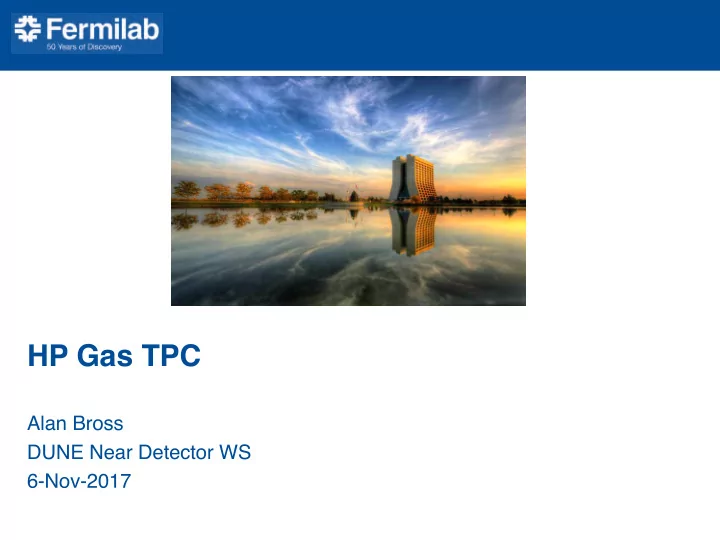

HP Gas TPC Alan Bross DUNE Near Detector WS 6-Nov-2017
HP Gas TPC • A magnetized Gas TPC provides two functions: – Aids in event containment for the LAr • High-resolution µ spectrometer • Hadronic energy – dE/dx (in conjunction with µ tag) for particle ID – Momentum measurement ( d p/p in range of a 1-5% in momentum range of interest) • This is very dependent on exact configuration details – Cryo wall thickness in radiation lengths, pressure vessel thickness, magnet geometry/coil thickness, etc. – Stand-alone experiment • At 10 ATM, neutrino event yield is ~3-5M n µ CC events in 3 yr n running – 97% of events on nucleons in Ar nuclei (P10 gas – 90-10 Ar-CH 4 ) • Possibly can reach 99% with optimized gas choice • A HP Gas TPC offers unprecedented “3D vertex visualization” for an electronic detector – Only surpassed by emulsion detectors 2 November 6, 2017 DUNE Near Detector WS
Our concept for HP Gas TPC • Re-purpose ALICE readout chambers – Existing chambers will be replaced in 2019 for High-lumi LHC • In discussion with ALICE management • Represents significant ~$5m contribution (if we used all chambers) – They have only operated at 1 ATM, but calculations indicated that operation at 10ATM looks doable without introducing electrostatic instability • Test stand now being setup at Fermilab using one of ALICE’s inner readout chambers (IROC) (See Guillermo’s talk) • Tremendous synergy with ArgonCube – Target nucleus • Not 100% Ar, but 90% Ar + 10% CH 4 is yields 97% – Raw 3-D data – Similar FE electronics architecture – Sam DAQ – Common data structure – Common pattern recognition, track finding, event recon. Algorithms – Light detection – maybe 3 November 6, 2017 DUNE Near Detector WS
ALICE TPC: Tracking efficiency 4 November 6, 2017 DUNE Near Detector WS
With excellent momentum and dE/dx resolution 5 November 6, 2017 DUNE Near Detector WS
Tracking + dE/dx +E/p is very powerful 6 November 6, 2017 DUNE Near Detector WS
Basic layout • Gas TPC: – Baseline we have been considering • 5m wide x 4.5m deep x 3.5m tall – 5m: Drift direction, 2.5m drift from center electrode – E parallel to B – However, this does not fit in baseline magnet • Jeremy will discuss next • Pressure vessel: – Could be rotated 90 o and would ~ double the active volume, but then the electronics is not accessible without removing the TPC 7 November 6, 2017 DUNE Near Detector WS
Interested groups and initial focus area • Fermilab TPC and mechanical engineering, simulations • SLAC DAQ • LBL Front-end electronics • Colorado Simulations • Harvard Simulations • MSU Low threshold/High-resolution tracking capabilities • Bern Integration with LAr • Aachen TPC gas studies 8 November 6, 2017 DUNE Near Detector WS
Questions and Answers (partial) • What is the realistic fiducial volume/mass for different vessels and readout concepts? – Reusing the ALICE readout chambers, we can instrument an active volume of ~ 140 m 3 . Assuming 10 ATM Ar operation, this is a total mass of ~ 2.5T. A detailed analysis still needs to be done, but a reasonable expectation is a Fid. Mass of ~1.25T • What is expected numuCC per POT? – Based on the above size, we calculate for the optimized 80 GeV, 204 X 2 DP LBNF beam, we obtain ~ 2.5M n µ CC events per year in the 1.25T Fid. Vol. • #POT is 1.47 X 10 21 /yr. (?) • What is the performance for pizero reconstruction in real environment (with rock muons and background events)? – Under study. From task force study, with good time-stamp on tracks escaping the TPC utilizing the ECAL, background is very small (<1%). • Can photons be reliably associated to particular events? – With proper ECAL, yes. Based on ALICE experience. • What about the coherent channel? – Not yet studied. But, the TPC will be very powerful for the detection of very forward tracks and statistics should be adequate. 9 November 6, 2017 DUNE Near Detector WS
Questions and Answers II • Is the good resolution and low threshold provided by HPTPC essential and useful for providing samples that give unique power in the oscillation program, i.e., samples with demonstrably better energy resolution or much better NC/CC separation than seen by other detectors (given insensitivity to neutrons and low rates)? – Under study. • Considering HPTPC in a dipole: what is the shape of the vessel? How is it oriented? What does the readout look like? For example, if it’s a cylinder, how is the long axis oriented and what direction do the electrons drift? How are they read out? This has implications for fiducial volume. – The vessel is cylindrical. Assuming a UA1-style magnet, the drift direction is perpendicular to the beam (mid-plane at HV and drift left and right from beam’s view). Dirft is parallel to B field direction. This is a requirement . The vessel is oriented perpendicular to the beam. Fid. Vol./Active vol ratio determination would require full detector/magnet optimization. What we have assumed above is 50%. • Must the ECAL be inside of the cryostat? What are the performance implications if it is (or is not)? – Current estimates on pressure vessel thickness (0.5 to 1 X 0 ) indicate that the ECAL could be either inside or outside. Requires detailed engineering and simulation iteration to determine what is best. • Cost of 3.5x3.5x5.0m3 HPTPC? – Under study. Requires engineering effort currently not available. 10 November 6, 2017 DUNE Near Detector WS
Required R&D • R&D on the TPC is very limited (nothing pushing state-of-the-art) – Gas mixture (reach 99% Ar equivalent) • Although P10 would be fine – Front-end electronics • The TPCs largest effort is likely to be in mechanical engineering 11 November 6, 2017 DUNE Near Detector WS
Recommend
More recommend